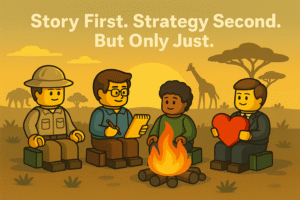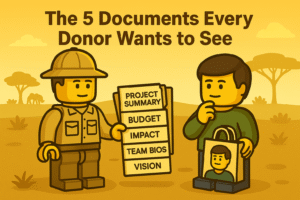Ask 10 conservation organisations what they do.
Most will say something like:
“We empower communities to protect biodiversity in threatened landscapes.”
Sounds noble.
But also… what does that even mean?
If your elevator pitch is full of buzzwords and people still don’t get what you do, you don’t need a copywriter.
You need clarity.
You Might Be Losing Support Because You’re Unclear, Not Unworthy.
Donors, partners, and team members aren’t sitting around trying to figure out what you mean.
If your message isn’t clear within 10 seconds, they move on.
Great conservation communication is specific, visual, and grounded in real work.
The 3-Part Clarity Framework
✅ 1. Who You Help
Start with the people, place, or species you serve.
📍 Example:
“We work with 4 rural villages bordering Kruger National Park Game Reserve…”
Not:
“We serve marginalised communities and conservation stakeholders.”
✅ 2. What You Do
Use action words and tangible programs.
📍 Example:
“…to train local youth as certified rangers and employ them in daily patrols.”
Not:
“…to build environmental resilience through capacity building.”
✅ 3. Why It Matters
Tie it to something concrete and urgent.
📍 Example:
“This keeps wildlife safe, creates jobs, and restores pride in wild Africa.”
Not:
“To promote holistic socio-ecological sustainability in rural ecosystems.”
Example:
Before:
“We foster nature-based solutions to climate and livelihood challenges.”
After:
“We teach unemployed youth to farm bees. They earn income. The bees protect crops. Everyone wins.”
Guess which version got funding?
Free Download
📥 Vision Clarity Framework (Fill-in-the-Blanks Worksheet)
Nail your message in 3 lines: who you help, what you do, and why it matters.
Your vision matters.
But if it’s unclear, generic, or wrapped in jargon it won’t stick.
Let’s rework your message so people can get it, feel it, and back it.
Can a 14-year-old understand what your organisation does and why it matters?
Let’s build your legacy Together
Book a free call to chat about where you need help


